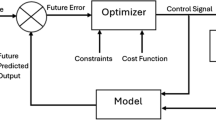Abstract
In this paper, a new hybrid scheme which combines radial basic function (RBF) neural network with a model following sliding mode control technique to take their common features is used to solve attitude control problem of gliding guide projectile. The attitude kinematics model described by second-order nonlinear uncertain system is divided into two single-input single-output subsystems by considering the nonlinearity as disturbance. To avoid generating high control value, the coupled inputs are kept as one nominal input instead of being included in lumped uncertainties. The uncertainties in the plant are cancelled by an adaptive RBF neural networks estimator, which is designed based on Lyapunov theory. To verify the effectiveness of the proposed control strategy, attitude tracking control experiments are simulated under strong internal and external disturbances.





Similar content being viewed by others
References
Li Y, Yang ZH, Cui NG (2008) A study of optimal trajectory for Boost-glide missile. J Astronaut 29(1):66–71
Shi JG, Wang ZY, Cao XB, Zhang BL (2007) Effect of motorial modes of gliding extended range projectile on range extended efficiency. Acta Armament 28(6):651–655
Akhtar A, Nielsen C, Waslander SL (2017) Path following using dynamic transverse feedback linearization for Car-Like robots. IEEE Trans Rob 31(2):269–279
Li HT, Yang S, Ren HL (2016) Dynamic decoupling control of DGCMG gimbal system via state feedback linearization. Mechatronics 36(2016):127–135
Liu C, Liu G, Fang JC (2016) Feedback linearization and extended state observer based control for rotor-AMBs system with mismatched uncertainties. IEEE Trans Industr Electron 64(2):1313–1322
Hamzaçebi H, Hömer M (2017) On the periodic gait stability of a multi-actuated spring-mass hopper model via partial feedback linearization. Nonlinear Dyn 88(2):1–20
Fang Z (2017) Control of an LLC resonant converter using load feedback linearization. IEEE Trans Power Electron 33(1):887–898
Hua CC, Liu G, Zhang L (2017) Cooperative stabilization for linear switched systems with asynchronous switching. IEEE Trans Syst Man Cybern Syst 49(6):1081–1087
Hua CC, Liu G, Zhang L (2017) Adaptive fuzzy prescribed performance control for nonlinearswitched time-delay systems with unmodeled dynamics. IEEE Trans Fuzzy Syst 26(4):1934–1945
Yang RG, Sun MW, Chen ZQ (2010) ADRC—based attitude control optimization and simulation. J Syst Simul 22(11):2689–2693
Precup RE (2017) Model-free sliding mode control of nonlinear systems: algorithms and experiments. Inf Sci 381(1):176–192
Shibasaki H, Ishida Y (2016) Modified model-following sliding mode control based on the active disturbance rejection control. In: 7th international conference on intelligent systems, modelling and simulation, pp 219–224
Liu D, Yang GH (2018) Performance-based data-drivenmodel-free adaptive sliding mode control for a class of discrete-time nonlinear processes. J Process Control 68(2018):186–194
Davijani NZ, Jahanfarnia G, Abharian E (2016) Nonlinear fractional sliding mode controller based on reduced order FNPK model for output power control of nuclear research reactors. IEEE Trans Nucl Sci 64(1):713–723
Mu B, Zhang K, Shi Y (2017) Integral sliding mode flight controller design for A quadrotor and the application in A heterogeneous multi-agent system. IEEE Trans Industr Electron 64(12):9389–9398
Tagne G, Talj R, Charara A (2013) Higher-order sliding mode control for lateral dynamics of autonomous vehicles, with experimental validation. In: 2013 IEEE intelligent vehicles symposium, pp 678–683
Wang B (2017) Integral sliding mode flight controller design for A quadrotor and the application in A heterogeneous multi-agent system. IEEE Trans Power Electron 33(9):7927–7937
Romdhane H, Dehri K, Nouri AS (2015) Second order sliding mode control for discrete decouplable multivariable systems via input-output models. Int J Autom Comput 12(6):630–638
Drakunov SV, Utkin VI (1992) Sliding mode control in dynamic systems. Int J Control 55(4):1029–1037
Emel’Yanov SV, Korovin SK, Levant A (1996) High-order sliding modes in control systems. Computat Math Model 7(3):294–318
Zhang YX (2007) Artificial neural networks based on principal component analysis input selection for clinical pattern recognition analysis. Talanta 73(1):68–75
He W, Chen Y, Zhao Y (2017) Adaptive neural network control of an uncertain robot with full-state constraints. IEEE Trans Cybern 46(3):620–629
Tong S (2017) Adaptive neural network output feedback control for stochastic nonlinear systems with unknown dead-zone and unmodeled dynamics. IEEE Trans Cybern 44(6):910–921
Luo S (2014) A Chaos RBF dynamics surface control of brushless DC motor with time delay based on tangent barrier Lyapunov function. Nonlinear Dyn 78(2):1193–1204
Ak AG, Cansever G (1995) Three link robot control with fuzzy sliding mode controller based on RBF neural network. In: Proceedings of IEEE 14th symposium on mass storage systems, pp 2719–2724
Sun Y, Wu CQ (2012) A radial-basis-function network-based method of estimating Lyapunov exponents from a scalar time series for analyzing nonlinear systems stability. Nonlinear Dyn 70(2):1689–1708
Song K (2016) On decoupling control of the VGT-EGR system in diesel engines: a new framework. IEEE Trans Control Syst Technol 24(5):1788–1796
Talole SE, Phadke SB (2016) Model following sliding mode control based on uncertainty and disturbance estimator. J Dyn Syst Meas Contr 130(3):034501–034505
Qian XF, Lin RX, Zhao YN (2008) Missile flight aerodynamics. In: Beijing institute of technology press, pp 90–111
Xu QP, Wang X, Wang Z (2018) Design of attitude decoupling controller for gliding guided projectile based on active disturbance rejection control. Syst Eng Electronics 40(2):384–392
Yan X, Yang S, Zhang C (2010) Coning motion of spinning missiles induced by the rate loop. J Guid Control Dyn 33(5):1490–1499
Ackermann J, Utkin VI (1998) Sliding mode control design based on Ackermann’s formula. IEEE Trans Automatic Control 43(2):234–237
Salle JL, Lefschetz S (1962) Stability by Liapunov’s direct method with applications. Phys Today 15(10):59
Acknowledgements
This work was supported in part of China Postdoctoral Science Foundation under Grant no. 2019M651838.
Author information
Authors and Affiliations
Corresponding author
Additional information
Publisher's Note
Springer Nature remains neutral with regard to jurisdictional claims in published maps and institutional affiliations.
Rights and permissions
About this article
Cite this article
Zhang, W., Yi, W. Adaptive Gliding-Guided Projectile Attitude Tracking Controller Design Based on RBF Neuro-sliding Mode Technique. Int. J. Aeronaut. Space Sci. 21, 504–512 (2020). https://doi.org/10.1007/s42405-019-00237-7
Received:
Revised:
Accepted:
Published:
Issue Date:
DOI: https://doi.org/10.1007/s42405-019-00237-7




